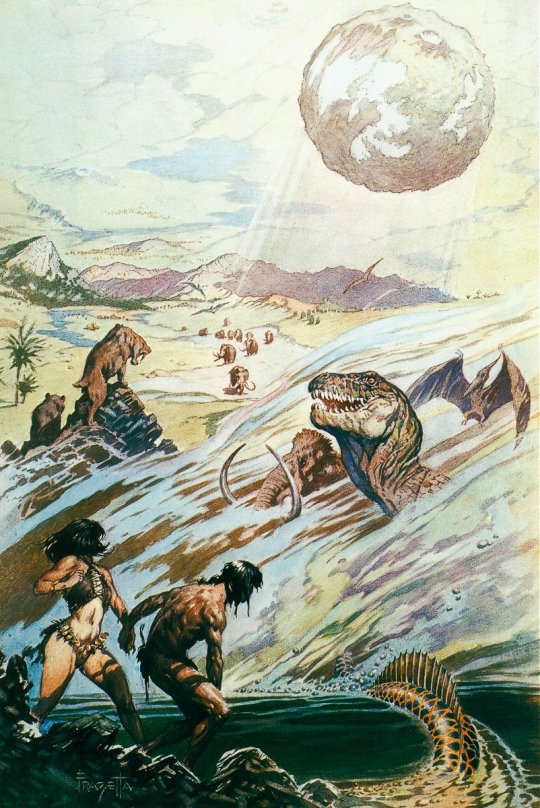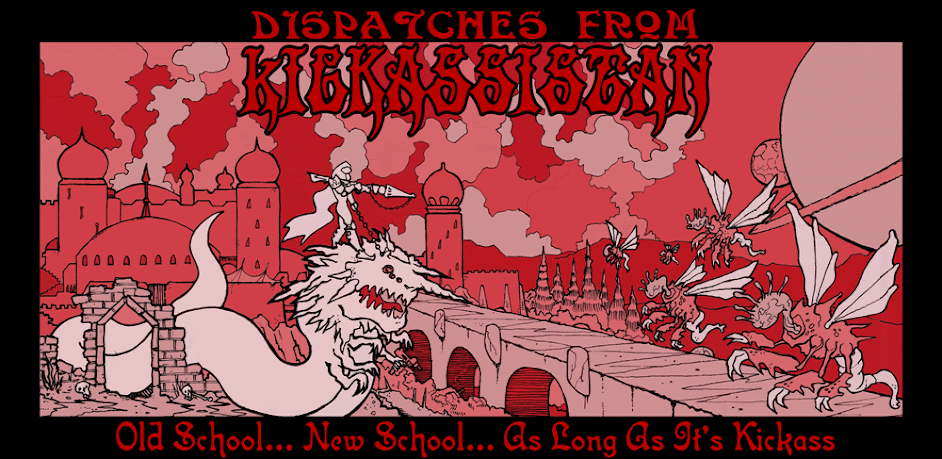Alright, it's time to get down to business and talk about how we're actually going to go about this whole dynamic hexcrawl shebang. I'll start off by saying that I've been putting this off because I hate telling people "this is how to do it;" in this case, I'm dodging that bullet and psyching myself up by telling myself that I'm not telling you how to do it, but telling you how I do it. Different things. The first is authoritative and wisdom coming down from on high, which almost always pisses me off. The second is more "this is what works for me, it might work for you." The distinction is really just academic and makes sense only insofar as you think about shit the way I do, which is sort of the point of all this in the first place, so good. Let's move on.
Another thing that I need to touch on before we get going is one of the underlying precepts of the dynamic hexcrawl process: it is a fucking process. It has some steps, a bit of "do this before you do that," but the whole thing is designed not to give you an end result, but to be a set of processes that work with you and your game (remembering that the game is only what happens at the table, no matter what anyone else tells you) to end up with better game-time and less (and more focused) prep-time. Like any process, the parts of this process should be examined as they are being enacted and tailored to suit your particular needs as a DM and the needs of your group. Always remember, though, that the point is learning to do more with less and learning to scrape by with as little as you can prepped beforehand.
We're going to start at the 24-mile hex scale initially, and that's what we're going to plan for. That's the scale that we're dealing in for this first part. Why seven hexes? Because it's one 24-mile hex in any direction from the central hex, one cluster of hexes around one central hex. That central hex is where everything starts, where your campaign will kick off. By now, you've been working on the aesthetic for your campaign, so you have an idea of what that starter hex is going to feel like, right? Great. Keep it at the forefront of your brain-space as we move forward, especially as we start to look at the hexes that will surround it and how the campaign's aesthetic will answer the question of "what's each hex like?"
Starting with your central hex, you want to think about two things that are in each hex that are worth talking about. Your starting hex probably has a town (or a city, if that's your thing) and a dungeon so that you can get to adventure quicker. This is basic Basic logic, well, basic Basic/Expert logic: start the game with a nearby dungeon option so that we can get into the dungeon mix as early as we can because somehow journeying into the mythic underworld that is your dungeon (with the appropriate apologies to Philotomy) -- at least in the upper levels -- will be less dangerous than journeying cross country (unless, of course, this doesn't mesh with your aesthetic).
Like I started off the last paragraph, you want to have two things worth knowing about each hex that surrounds the origin hex. These don't have to be earth-shattering, epic things or even Geoffrey McKinney-grade things. It can be simple. One of the things can be the terrain type (unless it's similar to other terrain types in the area), one can be a rumor, or a legend, or a monster lair or any one of a number of nearly endless possibilities. Here are some ideas:
Another thing that I need to touch on before we get going is one of the underlying precepts of the dynamic hexcrawl process: it is a fucking process. It has some steps, a bit of "do this before you do that," but the whole thing is designed not to give you an end result, but to be a set of processes that work with you and your game (remembering that the game is only what happens at the table, no matter what anyone else tells you) to end up with better game-time and less (and more focused) prep-time. Like any process, the parts of this process should be examined as they are being enacted and tailored to suit your particular needs as a DM and the needs of your group. Always remember, though, that the point is learning to do more with less and learning to scrape by with as little as you can prepped beforehand.
The First Seven Hexes
 |
| The Thunderlands, hex 0317 |
Starting with your central hex, you want to think about two things that are in each hex that are worth talking about. Your starting hex probably has a town (or a city, if that's your thing) and a dungeon so that you can get to adventure quicker. This is basic Basic logic, well, basic Basic/Expert logic: start the game with a nearby dungeon option so that we can get into the dungeon mix as early as we can because somehow journeying into the mythic underworld that is your dungeon (with the appropriate apologies to Philotomy) -- at least in the upper levels -- will be less dangerous than journeying cross country (unless, of course, this doesn't mesh with your aesthetic).
Like I started off the last paragraph, you want to have two things worth knowing about each hex that surrounds the origin hex. These don't have to be earth-shattering, epic things or even Geoffrey McKinney-grade things. It can be simple. One of the things can be the terrain type (unless it's similar to other terrain types in the area), one can be a rumor, or a legend, or a monster lair or any one of a number of nearly endless possibilities. Here are some ideas:
- A non-analogous terrain type. Borderlands, such as the one your adventures will probably take place in, often exist at the interstices between different types of terrain and there's no reason that that terrain can't begin in close proximity to the origin hex.
- A water source. A lake or a river or a sea. Rivers are almost a given, however, and you should probably focus on a larger body of water. Of course, it could be a fucking huge river, something like the Mississippi or the Rhine or Volga.
- A monster lair. This is going to be an obvious monster lair, the kind that mothers tell their children about to make them eat all their vegetables and behave. Probably a named monster. "THE chimera" or "THE manticore" or something more imaginative (please let it be something more imaginative!).
- A larger city or a smaller town. This exists in opposition to the settlement in the origin hex, so it should be differential from it. A big city is the place to go to sell loot, research lore (or magic), indulge exotic vices, and in need of adventurers to fuel its myriad plots. A small town is a place threatened by external forces and in need of adventurers to help secure its existence. Having both a larger city and a smaller town can create a lack of mobility ("why would we need to go anywhere else but these 7 hexes?") that can cut down on the adventuring fun of having a dynamic hexcrawl anyway.
- A natural wonder. This doesn't have to be "seven wonders of the world"-scale or even something of the stunning grandeur of Mt. Blanc or the Grand Canyon or the Great Barrier Reef, but it can be a distinct cool terrain feature that serves as a landmark.
- A legend. Maybe ghostly hosts are said to haunt the old battleground at the old crossing. Maybe that mountain is the place where the first sorcerers learned to wrench magic from the stars and rival the gods themselves. Maybe that island awaits the return of the World's True Emperor to reclaim his throne there, on that vaguely chair-shaped rock that was once his throne in an age long past. Stuff like that. Have fun.
- Something everyone is afraid of. People don't even have to talk about the thing that they're afraid of, or maybe they only do in hushed whispers, but everyone knows it's there.
- Something everyone covets. The standard fantasy trope here is "ye olde dwarven mine," but it could be anything. How many real-world wars have been fought over land? You get the idea.
- Something weird. This shouldn't be "ZOMGONZO!"... ever. Stuff can be -- and needs to be -- weird without being stupid or cutesy or campy or (as it's so often misused) "random." Something fantastic, bizarre, perhaps supernatural (that's the "weird" in Weird Tales, peeps) that fits with your aesthetic and perhaps contrasts elements of it. Stupid or cutesy or campy can fit, however, if that's an extension of your aesthetic, just... be careful, man...
- Something of religious significance. To someone, somewhere. Probably to locals, but who knows? Maybe there's a religion on the other side of the globe that sends pilgrims here because it's where their founder first plucked a particular sort of flower that the religion holds as sacred. Remember that religions don't have to be all big and smashy and if they weren't part of daily life for folks, they'd probably never get off the ground.
- Make up a bunch more stuff as makes sense for your aesthetic. If it makes sense to have a bunch of castles and knightly orders (if that's your kind of thing), go ahead and do it. Of course, you could be more creative than that, which is what I recommend.
There are so many other things you could fit into your first seven hexes that there's no way I'll be able to think of them all now. That's a good thing. My goal here isn't to give you a check list, but to inspire you to figure out your own stuff, which I think is kind of presumptuous and arrogant of me to assume that this post was. Even if you didn't find a concrete idea here, then, let me hope that you found that my list of suggestions failed to include something that you think is important and let your irritation with me serve as inspiration. I'll accept that. That's good enough for me.
You also will probably want to draw these seven hexes on your map. I will probably have more to say about that very soon.
